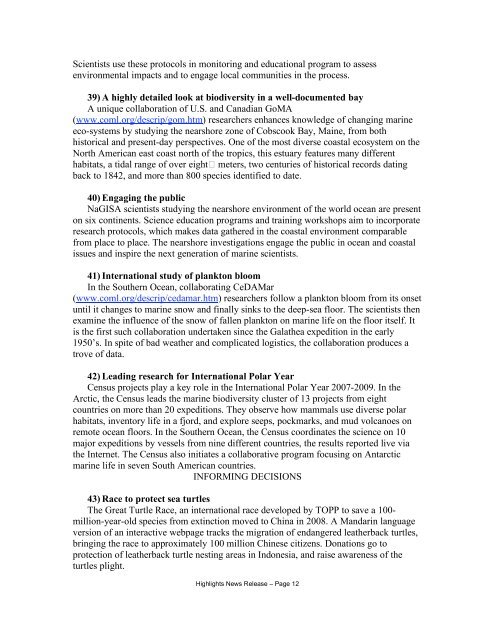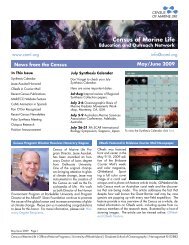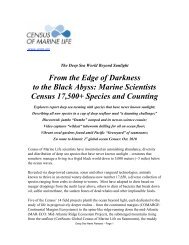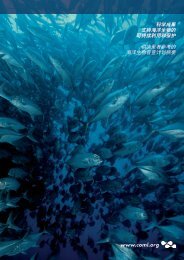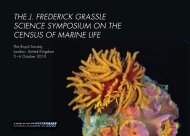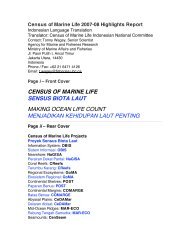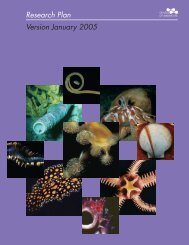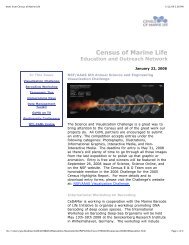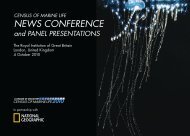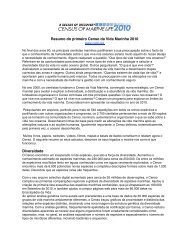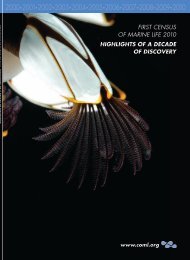Full press release - Census of Marine Life
Full press release - Census of Marine Life
Full press release - Census of Marine Life
You also want an ePaper? Increase the reach of your titles
YUMPU automatically turns print PDFs into web optimized ePapers that Google loves.
Scientists use these protocols in monitoring and educational program to assessenvironmental impacts and to engage local communities in the process.39) A highly detailed look at biodiversity in a well-documented bayA unique collaboration <strong>of</strong> U.S. and Canadian GoMA(www.coml.org/descrip/gom.htm) researchers enhances knowledge <strong>of</strong> changing marineeco-systems by studying the nearshore zone <strong>of</strong> Cobscook Bay, Maine, from bothhistorical and present-day perspectives. One <strong>of</strong> the most diverse coastal ecosystem on theNorth American east coast north <strong>of</strong> the tropics, this estuary features many differenthabitats, a tidal range <strong>of</strong> over eight meters, two centuries <strong>of</strong> historical records datingback to 1842, and more than 800 species identified to date.40) Engaging the publicNaGISA scientists studying the nearshore environment <strong>of</strong> the world ocean are presenton six continents. Science education programs and training workshops aim to incorporateresearch protocols, which makes data gathered in the coastal environment comparablefrom place to place. The nearshore investigations engage the public in ocean and coastalissues and inspire the next generation <strong>of</strong> marine scientists.41) International study <strong>of</strong> plankton bloomIn the Southern Ocean, collaborating CeDAMar(www.coml.org/descrip/cedamar.htm) researchers follow a plankton bloom from its onsetuntil it changes to marine snow and finally sinks to the deep-sea floor. The scientists thenexamine the influence <strong>of</strong> the snow <strong>of</strong> fallen plankton on marine life on the floor itself. Itis the first such collaboration undertaken since the Galathea expedition in the early1950’s. In spite <strong>of</strong> bad weather and complicated logistics, the collaboration produces atrove <strong>of</strong> data.42) Leading research for International Polar Year<strong>Census</strong> projects play a key role in the International Polar Year 2007-2009. In theArctic, the <strong>Census</strong> leads the marine biodiversity cluster <strong>of</strong> 13 projects from eightcountries on more than 20 expeditions. They observe how mammals use diverse polarhabitats, inventory life in a fjord, and explore seeps, pockmarks, and mud volcanoes onremote ocean floors. In the Southern Ocean, the <strong>Census</strong> coordinates the science on 10major expeditions by vessels from nine different countries, the results reported live viathe Internet. The <strong>Census</strong> also initiates a collaborative program focusing on Antarcticmarine life in seven South American countries.INFORMING DECISIONS43) Race to protect sea turtlesThe Great Turtle Race, an international race developed by TOPP to save a 100-million-year-old species from extinction moved to China in 2008. A Mandarin languageversion <strong>of</strong> an interactive webpage tracks the migration <strong>of</strong> endangered leatherback turtles,bringing the race to approximately 100 million Chinese citizens. Donations go toprotection <strong>of</strong> leatherback turtle nesting areas in Indonesia, and raise awareness <strong>of</strong> theturtles plight.Highlights News Release – Page 12


